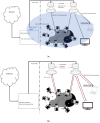Visible Light Communication: A System Perspective-Overview and Challenges
- PMID: 30866473
- PMCID: PMC6427442
- DOI: 10.3390/s19051153
Visible Light Communication: A System Perspective-Overview and Challenges
Abstract
Visible light communication (VLC) is a new paradigm that could revolutionise the future of wireless communication. In VLC, information is transmitted through modulating the visible light spectrum (400⁻700 nm) that is used for illumination. Analytical and experimental work has shown the potential of VLC to provide high-speed data communication with the added advantage of improved energy efficiency and communication security/privacy. VLC is still in the early phase of research. There are fewer review articles published on this topic mostly addressing the physical layer research. Unlike other reviews, this article gives a system prespective of VLC along with the survey on existing literature and potential challenges toward the implementation and integration of VLC.
Keywords: LED communication; VLC networks; optical communication; visible light communication.
Conflict of interest statement
The authors declare no conflict of interest.
Figures
References
-
- Cho J., Park J.H., Kim J.K., Schubert E.F. White light-emitting diodes: History, progress, and future. Laser Photonics Rev. 2017;11:1600147. doi: 10.1002/lpor.201600147. - DOI
-
- Nardelli A., Deuschle E., de Azevedo L.D., Pessoa J.L.N., Ghisi E. Assessment of Light Emitting Diodes technology for general lighting: A critical review. Renew. Sustain. Energy Rev. 2017;75:368–379. doi: 10.1016/j.rser.2016.11.002. - DOI
-
- Aslan J., Mayers K., Koomey J.G., France C. Electricity intensity of Internet data transmission: Untangling the estimates. J. Ind. Ecol. 2018;22:785–798. doi: 10.1111/jiec.12630. - DOI
-
- Belkhir L., Elmeligi A. Assessing ICT global emissions footprint: Trends to 2040 and recommendations. J. Clean. Prod. 2018;177:448–463. doi: 10.1016/j.jclepro.2017.12.239. - DOI
-
- Andrae A.S., Edler T. On global electricity usage of communication technology: Trends to 2030. Challenges. 2015;6:117–157. doi: 10.3390/challe6010117. - DOI
Publication types
LinkOut - more resources
Full Text Sources
Other Literature Sources




